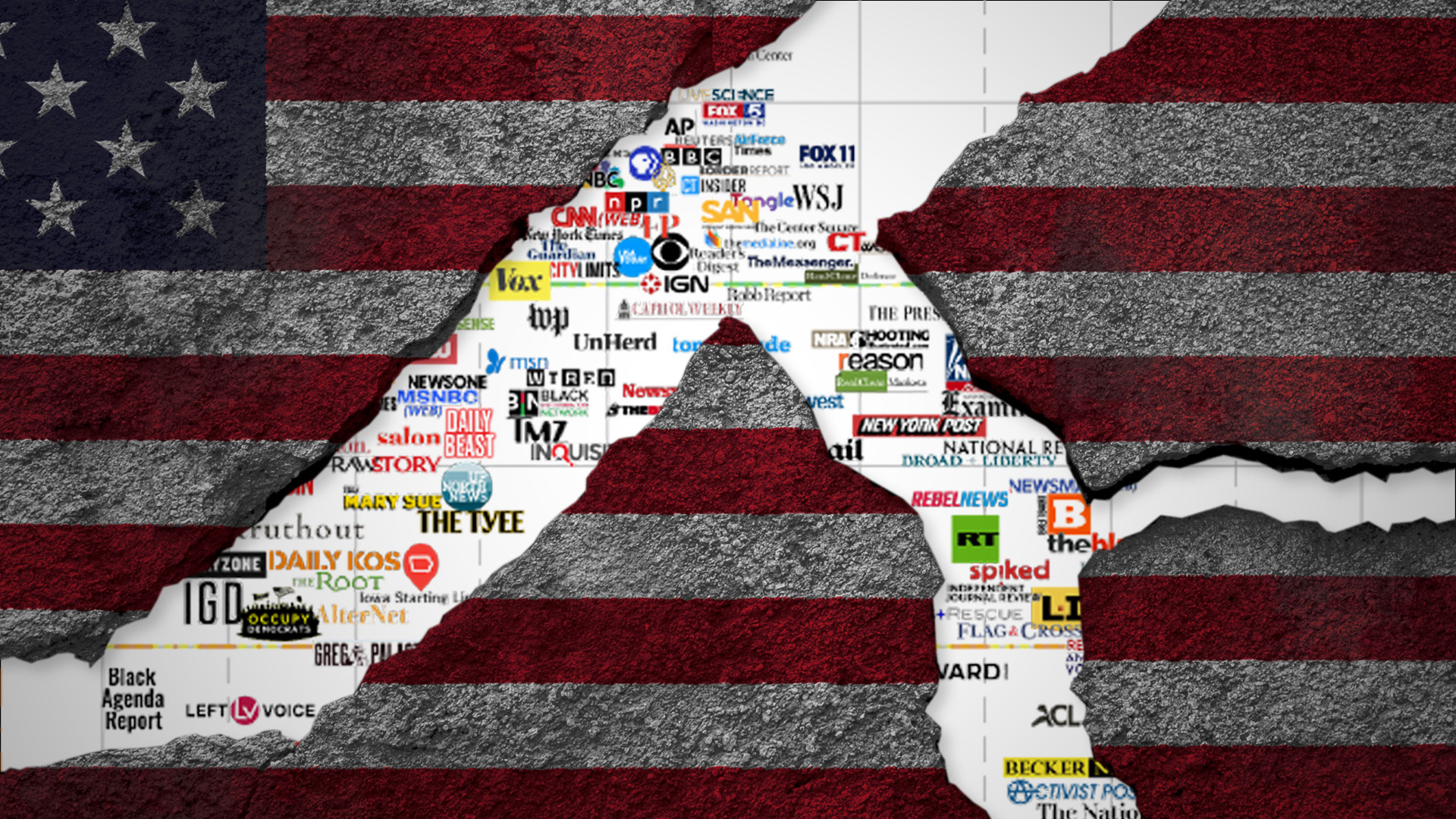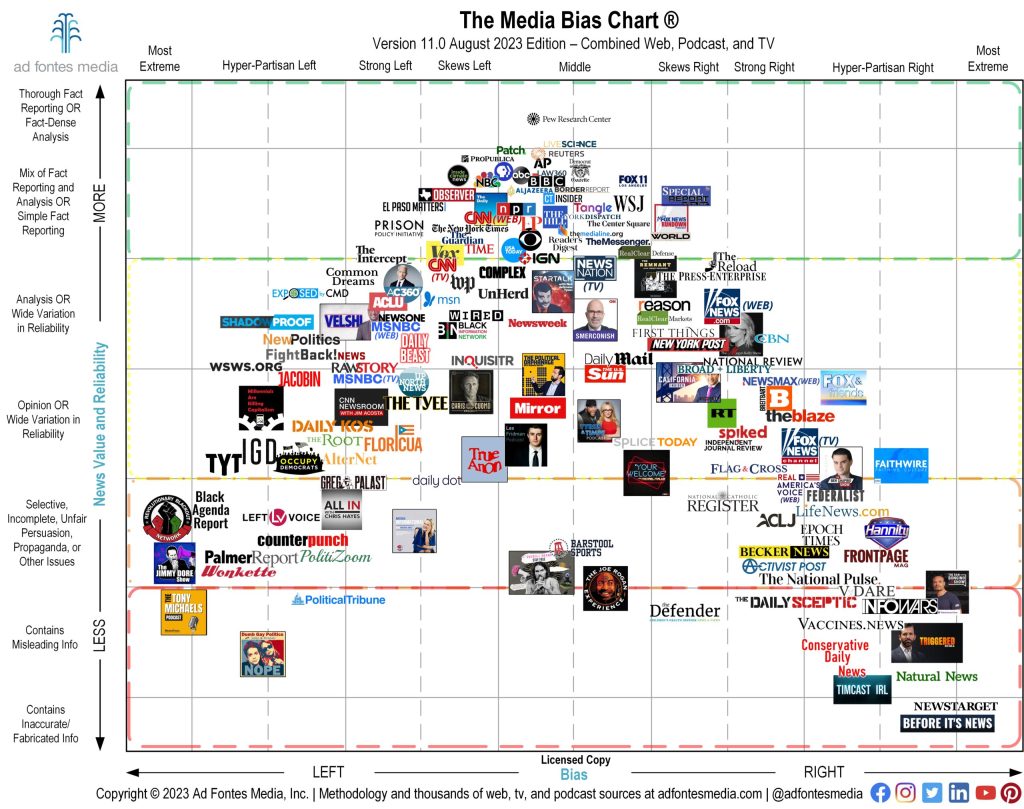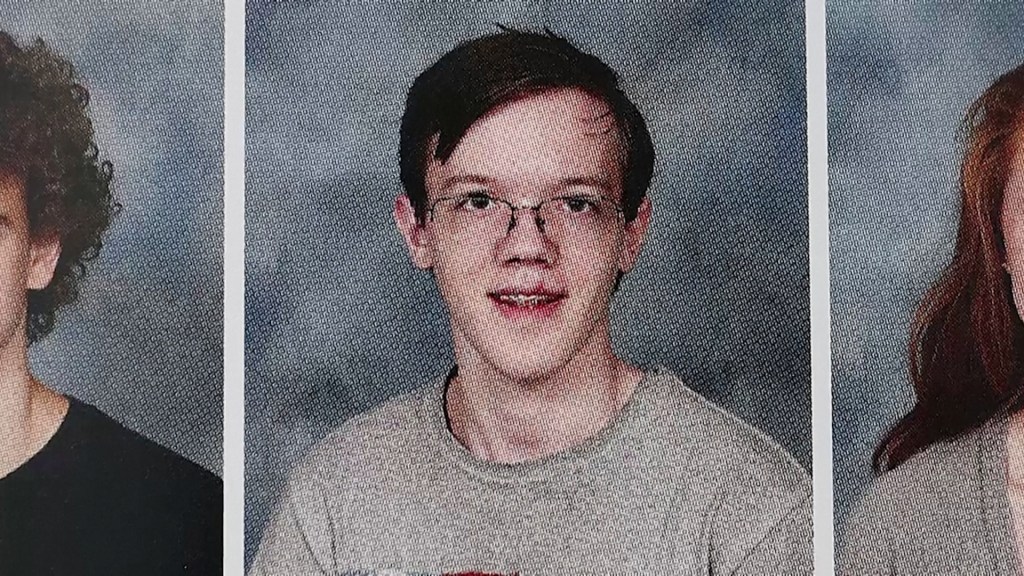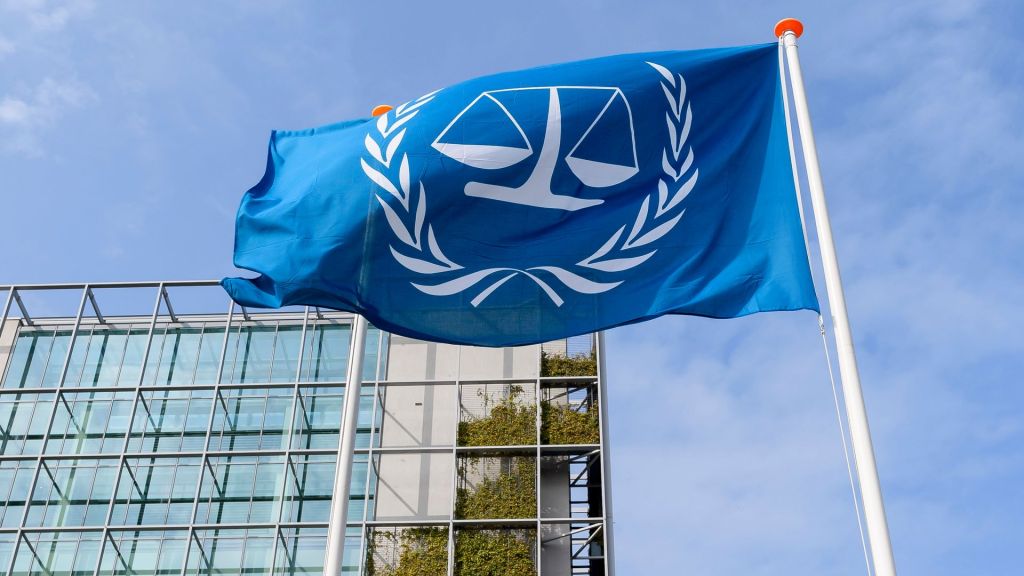
SIMONE DEL ROSARIO: THE STAGE IS SET. AS AMERICANS GEAR UP FOR THE NEXT PRESIDENTIAL ELECTION, MEDIA BIAS WILL BE ON THE MIND. FOR THE FIRST TIME LAST YEAR, MORE AMERICANS SAID THEY DIDN’T TRUST MEDIA AT ALL – THEN THOSE WHO SAID THEY TRUST MEDIA A FAIR OR GREAT AMOUNT. SEARCHES FOR UNBIASED NEWS SOURCES SPIKE AS VOTERS HEAD TO THE POLLS AND MY NEXT GUEST AIMS TO HELP PEOPLE NAVIGATE THE MEDIA TERRAIN WITH A SIMPLE CHART. VANESSA OTERO IS FOUNDER AND CEO OF AD FONTES MEDIA AND CREATOR OF THE MEDIA BIAS CHART. OVER THE NEXT 10 MINUTES WE’RE GOING TO TALK ABOUT WHETHER MEDIA BIAS IS GETTING WORSE – WE’RE GOING TO STACK UP NEWS OUTLETS CLAIMING TO BE UNBIASED WITH WHERE THEY ACTUALLY LAND ON THE CHART (YOU KNOW THE ONES) – AND TOWARD THE END OF OUR CONVERSATION VANESSA SHARES WHAT IS UNSETTLING ABOUT THE CONTENT BEING SHARED TODAY, AND WHAT WE CAN DO ABOUT IT.
Vanessa, how have you seen the media bias landscape change since you started analyzing this in 2016?
VANESSA OTERO: It’s a great question. It’s grown. There’s just more and more and more new sources out there and news and information sources out there every day. Unfortunately, one way it hasn’t changed is that it’s still quite polarizing. When I started the the media bias chart in 2016, the impetus of it was really the fact that there were so many polarizing news sources and people are fighting over them. Unfortunately, that’s still the case. But there’s just more to navigate.
SIMONE DEL ROSARIO: Vanessa, would you say there are more hyper partisan options now? Or more options in the middle?
VANESSA OTERO: I think there’s more of both right? There are a lot of news sources that that are in the middle. Most of the news sources we rate actually, like the majority, tend to be less biased, but the ones that are on the far left and right, they’re the loudest, and they seem to get most of the attention. So there’s really more of both. But because there are so many new sources to choose from people have to be really intentional about seeking out things that are minimally biased, and highly reliable.
SIMONE DEL ROSARIO: What does that tell us about Americans consumption of news, if the ones on the edges are getting more viewership, more attention?
VANESSA OTERO: Well, look, folks are polarized. Every poll that you look at just shows like increasing and increasing polarization over the last 10 years, 20 years, 30 years, and not just polarization, but what’s called affective polarization, like the kind where it makes you dislike, distrust, even hate folks on the other side, that I think is really damaging and dangerous. You know, when you’re not assuming the, the folks on the other side have good intentions, when you’re just assuming that they disagree with you because they’re stupid or evil are both, you know, it’s really hard to come to any kind of consensus. But things that you agree with, they tend to give you this confirmation bias. You know, we’re sort of programmed to like things that we already agree with. So I mean, what it tells you about Americans is that, you know, we can fall into those traps really easily. It’s not hopeless, though, you know, we can do something about it, we can recognize that something that we’re like strongly agreeing with is like just feeding our confirmation bias. That maybe that’s not the most effective way to make decisions, or live your life. You can see that when you’ve got, like, if politics is dividing your family, your friends, you’re not able to have conversations with folks, it may be an indication that you’re really focusing on very polarizing news sources.
SIMONE DEL ROSARIO: Okay, this is going to be a hard question to answer. It’s sort of a chicken versus the egg argument. Do you think that more media bias is increasing political division, or do you think it’s the other way Around.
VANESSA OTERO: Great question. The causes of polarization are many, you know, there are constitutional causes, you know, cause you can have politicians that drive polarization. But the media is a big part of it, you know, it’s a stakeholders in our democracy. There are there are many, there’s, you know, the citizenry, there are the politicians, there’s the media, and each influence each other in a push and pull kind of way. So, one thing we’ve seen over the years, since the advent of cable news, really, is the participation of politicians in media. I mean, how often do you look at a cable news show, and politicians are on the cable news show? I mean, this happens all night, every night, every channel, right? So the media, and politicians are part of the media. And politicians, just like every other citizen, are susceptible to confirmation bias, to being wrapped up in their own side stuff, like not being able to filter out, you know, highly reliable versus low, reliable information. I don’t know if you notice, but you know, there are some politicians that are not very good. It’s telling what’s true in the news, and participating, they participate in the extreme bias of the news. So I think it’s really a combination of both where they feed off each other.
SIMONE DEL ROSARIO: Okay, so CNN says they’re unbiased. Fox dropped the fair and balanced but says they’re the most trusted. What does your analysis say?
VANESSA OTERO: It’s funny what you say, as a slogan. And what you actually do can be different things. Also, how people perceive you can be really different things. So one of the most common ways of measuring media bias, is consumer opinion polling, like asking people, well, how much do you trust Fox, or CNN or MSNBC? And really, the answer to that question tells you so much more about the person and their politics than it does about the news source. So the way we go about it is by analyzing the content, which is it’s hard to do, like it’s a little bit easier to pull a bunch of folks and say, What do you think about this, but the content itself has the answers, you can look at the headlines and the graphics and each individual sentence, you can see how they’re expressed this fact analysis opinion. And you can fact check the claims that are in there, you can see if they advocate for left or right political positions, you can see how they refer to their political issues or opponents. So you can actually tell from looking at the content. So what our data shows, it is that you know, Fox is right leaning, CNN is left leaning, MSNBC is left leaning a little bit more so than CNN. And they have varying levels of reliability. What’s really fascinating is that Internet content, like going to cnn.com, or Fox news.com, or msnbc.com, tends to be less biased and more reliable than their TV counterparts, which have, of course, a lot of primetime opinion programming. And opinion programming really isn’t news.
SIMONE DEL ROSARIO: It is our belief that Americans are hungry for unbiased news. That is why Straight Arrow News is here. How is Straight Arrow News doing in that mission, according to your analysis?
VANESSA OTERO: Really well, you know, I think Straight Arrow News is correct in the assumption that people are looking for unbiased news. Now, of course, you know, everyone has some bias, right? There’s, it’s really hard to be unbiased. But you can mitigate your bias as best you can by trying by, you’re showing balance by being you’re describing things as straightforwardly as possible. We’ve seen so many Americans say like, yes, we want unbiased news, like Can, can I just go turn something on where I’m not being told what to think? Or I’m just getting the facts, right. People say that all the time. It’s one of the reasons you see this level of trust declining in those opinion polls. People don’t trust news when it’s more full of opinion and analysis than actual fact reporting. So you know, Straight Arrow News is right in the middle, for bias in our on our chart, that middle section is labeled minimal or balanced bias. And it’s rated as highly reliable. And look, that’s what we’re looking for in the media landscape. That’s what we want. Like we want to promote the work of good journalists that are bringing folks facts that they wouldn’t otherwise be able to find on their own.
SIMONE DEL ROSARIO: I looked at the history of Google search trends and the search for unbiased news sources was never higher than in November of 2020. What does that tell us about what Americans are looking for as they go to the polls?
VANESSA OTERO: So much. We actually did some studies around, you know, social media, and monitoring the spread of you biased and unreliable information. before, during, and after the November 2020 election. And there was a marked increase in the myths and misinformation and polarizing content being shared just across the board. You’re given that people have this have a need, they have a desire to want to be well informed. They don’t want to feel lost, right? Like you don’t want to go around like not knowing what’s true. It’s very disorienting. It’s very unsettling. So, I mean, what that tells me is that, you know, Americans recognize the problem, you know, Americans are smart. They realize when there’s like this flood of information that they have to sort through and unfortunately, because there’s so many new sources, you’re the responsibility falls on folks to sort through them, you know, are that’s that’s why we exist is because no one has time to sort through 10s of 1000s of information sources. So we’re a reference point, right? Like, ultimately, people should make the determinations for themselves learn to recognize reliability and bias. But when there are just so many out there, it’s really helpful to have a guidepost. And so we just hope we can be that for folks.
SIMONE DEL ROSARIO: Vanessa Otero founder and CEO of Ad Fontes Media, really appreciate your time today.
VANESSA OTERO: Thank you so much Simone.







